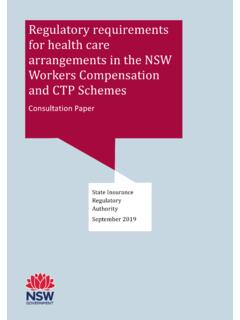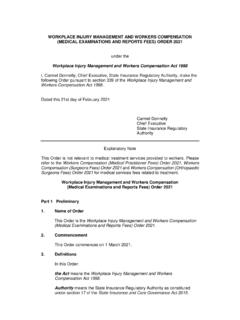Transcription of Guidelines for the management of acute whiplash associated ...
1 Guidelines for the management of acute whiplash associated disorders for health Edition 2014 Suggested citation:This report should be cited as: State Insurance Regulatory Authority: Guidelines for the management of acute whiplash - associated disorders for health professionals. Sydney: third edition document is endorsed by: Guidelines for the management of acute whiplash - associated disorders for health professionals, third edition may copy, distribute, display and otherwise freely deal with this work for any purpose, provided that you attribute the State Insurance Regulatory Authority (SIRA)1 as the owner. However, you must obtain permission if you wish to (1) charge others for access to the work (other than at cost), (2) include the work in advertising or product for sale, or (3) modify the : 978-1-921422-34-8 This document is available on the SIRA website, On 1 September 2015, the functions of the Motor Accidents Authority (MAA) were assumed by the State Insurance Regulatory Authority (SIRA).
2 Working group members 1 Preface 3 Purpose of the Guidelines 4 Definition 4 Development of the Guidelines 6 Summary of recommendations 12 Recommendations for clinical practice 14 Recommendations for assessment and diagnosis 15 Recommendations for prognosis 19 Recommendations for treatment 27 Appendices 38 References 53 Contents1 Thank you to the members of the working group who guided this working group was established recognising that primary care health professionals, especially general practitioners, physiotherapists and chiropractors, manage most of the treatment arising from whiplash - associated disorders (WAD).
3 REPRESENTATIVEPOSITIONORGANISATIONROLET echnical membersProfessor Ian Cameron* Professor of Rehabilitation Medicine, University of SydneyUniversity of Sydney Subject matter expert**Associate Professor Lisa Harvey*Associate Professor, University of SydneyUniversity of SydneyEpidemiologist Dr Joe Ierano*President, Chiropractors Asssociation of Australia (NSW Branch)Chiropractors Association Australia NSW BranchProfessional representativeDr Jagnoor JagnoorPost-doctoral Fellow, University of SydneyUniversity of SydneyAuthorDr Kathryn Nicholson Perry*Senior Lecturer University of Western SydneyAustralian Psychological Society NSW BranchProfessional representativeDr Trudy Rebbeck*Specialist Musculoskeletal PhysiotherapistAustralian Physiotherapy Association NSW Branch Professional representativeProfessor Michele Sterling*NHMRC Research Fellow Associate Director Centre for National Research on Disability and Rehabilitation Medicine (CONROD)
4 University of QueenslandSubject matter expert**Dr Clive Sun* Consultant in Rehabilitation Medicine and Pain Medicine, St Vincent s Hospital Australasian Faculty of Rehabilitation MedicineProfessional representativeProfessor Simon Wilcock*Professor and Head, Discipline of General Practice, Sydney Medical ProgramUniversity of SydneySubject matter expert**Industry membersMs Katie CooleyRehabilitation Manager, Claims, QBE InsuranceInsurance Council of AustraliaIndustry representativeMs Naomi QuinnSenior Health and Road Safety Advisor, CTP Scheme Design Policy and Injury Prevention NRMA InsuranceInsurance Council of AustraliaIndustry representativeRegulator membersMs Tina BideseActing Manager, Injury StrategyMotor Accidents Authority (now SIRA)Regulator representativeMs Liz GeeSenior Advisor, Injury StrategyMotor Accidents Authority (now SIRA)Chairperson, Regulator representativeMs Penny WeissInjury Strategy Advisor, Injury StrategyMotor Accidents Authority (now SIRA)Regulator representative* Denotes also a member of the scientific advisory committee.
5 ** Appointed by the then group members2 The working group provided a mechanism to consult with all relevant stakeholder groups, to reach consensus agreement and advise on necessary revisions of the Guidelines for the management of acute whiplash - associated disorders second edition 2007 and associated documents. The role of the working group was to: consider the recommendations of the systematic review, identify any additional areas, and provide recommendations for updating the Guidelines and associated documents provide advice on implementation of the revised Guidelines across relevant professional groups, CTP insurers and claimants with WAD. The scientific advisory committee, a subcommittee of the working group, provided clinical and research expertise on the literature identified by the systematic review and other searches.
6 Membership to the scientific advisory committee was determined at the first working group meeting. The scientific advisory committee reported back to the working group at each the commencement of the Guidelines development process, the working group members were asked to declare any conflict of interest, perceived or otherwise. There was no conflict of interest declared that had a material impact on the review of these developed new Guidelines for the management of whiplash - associated disorders (WAD), which is the single most frequently recorded injury among compulsory third party (CTP) claimants in NSW. Of all the claims lodged since 2007, 46 per cent of claimants had WAD as one of their reported injuries. These Guidelines provide recommendations to health professionals, insurers and patients for the best possible management of adults with WAD in the first 12 weeks following a motor vehicle crash (MVC).
7 The first edition of the Guidelines was developed in They were based on an update of the Quebec Task Force (QTF) Guidelines , released in 19952 that reviewed 10,000 publications and focused on clinical issues, specifically risk, diagnosis, prognosis and treatment of WAD. The second edition of the Guidelines was published in A comprehensive review was undertaken using the MAA 2001 WAD Guidelines as a starting point. The aim was to systematically review and summarise relevant literature from 1999 to November 2005 on the assessment and diagnosis, the prognosis and the effectiveness of treatment in people with acute and subacute (less than 12 weeks duration) WAD. This third edition (2014) of the Guidelines includes more recently published evidence based recommendations for the management of acute WAD.
8 A systematic review was undertaken to identify and summarise relevant literature from 2005 to July 2012. Recommendations for practice were developed by the working group on the basis of the current evidence. For areas of practice not adequately addressed by research, recommendations were developed based on expert consensus. A complete guide to the methods used can be found in the accompanying Technical Guidelines cover the first 12 weeks following an MVC. However, they recognise that each person s experience of recovery is different and the natural course of the condition can go beyond the acute phase addressed here. Clinical utility has been given utmost importance by the team working on this project. We hope that these Guidelines will be useful to health professionals, people with WAD and the insurance Guidelines are intended to assist health professionals delivering primary care to adults (18 years and beyond) with acute or subacute simple neck pain after an MVC in the context of CTP Guidelines specifically seek to assist health professionals to:DefinitionGrades of WADT able 1.
9 Quebec Task Force classification of Grades of WAD conduct a comprehensive assessment and physical examination classify the WAD grade according to the QTF classification system apply the Canadian C-Spine rule to determine whether an X-ray is required to confirm the diagnosis of a fracture or dislocation consider the role of radiological imaging and special tests identify clinical and psychosocial risk factors inform and educate patients and emphasise the importance of staying positive and active review progress including physical and psychological status and take recommended action encourage coordinated care for improved health QTF definition of WAD has been adopted as the definition of acute or subacute simple neck pain for the purposes of these Guidelines .
10 It states: whiplash is an acceleration-deceleration mechanism of energy transfer to the neck. It may result from .. motor vehicle collisions .. The impact may result in bony or soft tissue injuries ( whiplash injury), which in turn may lead to a variety of clinical manifestations ( whiplash - associated disorders ).2 The clinical classification of grades of WAD provided by the QTF is shown in the table below. Symptoms and disorders that can manifest in all grades include deafness, dizziness, tinnitus, headache, memory loss, dysphagia and temporomandibular joint of these GuidelinesGRADECLASSIFICATION0No complaint about the physical sign(s).IComplaint of neck pain, stiffness or tenderness only. No physical sign(s).IINeck complaint AND musculoskeletal sign(s).









